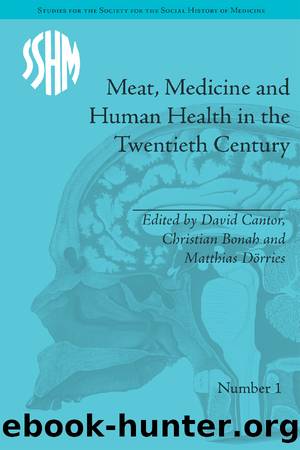Meat, Medicine and Human Health in the Twentieth Century by Christian Bonah David Cantor Mathias Dörries

Author:Christian Bonah, David Cantor, Mathias Dörries [Christian Bonah, David Cantor, Mathias Dörries]
Language: eng
Format: epub
Tags: Nonfiction, Health & Well Being, Medical, Reference, History
ISBN: 9781317323198
Publisher: Taylor and Francis
Published: 2015-10-06T04:00:00+00:00
Though Jordan detailed many health problems that could arise from meat eating, and some of the benefits, ultimately he determined his position by the cultural stature of flesh protein. In effect, meat is a status symbol.
Jordan could not settle on the healthfulness of meat but others had no such difficulties. Throughout the century, advocates found many reasons to celebrate the positive attributes of meat for adults as well as children. Animal protein was good because it cured anaemia, it encouraged the digestive juices and thus aided digestion, it complemented other foods and made them more attractive. Contemporary ethnographic studies confirmed the healthfulness of meat. The lives of Eskimos and of the explorers who lived with them provided evidence that all meat diets were highly successful.23 Meat contained high-quality protein to build strong muscles and was also a good source of thiamine, iron and phosphorus.24 The iron content of meat was especially important for womenâs health. By the end of the twentieth century, nutritionists particularly were concerned that women wanting to lose weight would cut back on meat in order to save calories. They insisted that women needed meat for its iron and urged them to âeat red meat, fish, or dark-meat poultry at least once a day. These animal foods contain heme iron, the type that our bodies absorb and use bestâ, they reminded dieters.25
By mid-century, a popular theme in promoting meat involved the value of its eight essential amino acids. In her widely read Letâs Eat Right to Keep Fit, Adelle Davis, nutrition guru of the period, instructed readers on the importance of protein in keeping them young, and thus healthy. She explained that âOnly when protein of excellent quality is supplied can each cell function normally and keep itself in constant repairâ.26 With adequate protein the body produced sufficient energy and âlife is made easierâ.27 Davis warned her readers that all protein was not the same; its value was related to its amino acids. Humans need twenty-two amino acids, fourteen of which can be manufactured by the body. The remaining eight, the so-called essential amino acids, must be obtained from food and proteins that contain all eight are called complete or adequate. Davis informed her readers on the role of the amino acids in nutrition and on how to identify suitable sources of protein. Her guidelines:
Protein from muscle meats, used in roasts, steaks, and chops, are complete but contain fewer of some essential amino acids that do glandular meats and are therefore less valuable. On the whole, animal proteins, such as meat, fish, eggs, milk, and cheese, contain more essential amino acids in greater abundance than do vegetable proteins; hence they have superior value.28
Download
This site does not store any files on its server. We only index and link to content provided by other sites. Please contact the content providers to delete copyright contents if any and email us, we'll remove relevant links or contents immediately.
Application of a Novel Technique for Clinical Evaluation of Nitric Oxide-Induced Free Radical Reactions in ICU Patients by Unknown(696)
Rosenâs Emergency Medicine Concepts and Clinical Practice by Ron Walls; Robert Hockberger; Marianne Gausche-Hill; Timothy B. Erickson; Susan R. Wilcox(572)
Oxidative damage to surfactant protein D in pulmonary diseases by Vitality Starosta1 & Matthias Griese1†(408)
Social Science Perspectives on Global Public Health by Vincent La Placa & Julia Morgan(375)
Constructing Canine Consent; Conceptualising and Adopting a Consent-focused Relationship with Dogs by ERIN JONES(330)
Organic Chemistry: An Acid - Base Approach by MICHAEL SMITH(300)
ADVANCED EMERGENCY CARE AND TRANSPORTATION OF THE SICK AND INJURED by Unknown(271)
Saunders Nursing Drug Handbook 2024 - E-Book by Unknown(263)
Davis's Comprehensive Manual of Laboratory and Diagnostic Tests with Nursing Implications by Unknown(249)
Socio-Life Science and the COVID-19 Outbreak : Public Health and Public Policy by Makoto Yano; Fumihiko Matsuda; Anavaj Sakuntabhai; Shigeru Hirota(247)
Diagnostic and Statistical Manual of Mental Disorders, Fifth Edition, Text Revision (DSM-5-TR(tm)) by Unknown(246)
Human Microanatomy; Cell Tissue and Organ Histology with Celebrity Medical Histories by Stephen A. Stricker(245)
Berne and Levy Physiology E-Book by Unknown(236)
Replacing the Dead by Mie Nakachi;(231)
Handbook of Skin Disease Management by Jiyad Zainab;Flohr Carsten; & Carsten Flohr(229)
Access to Medicines and Vaccines in the South : Coherence of Rules and Policies Applied by the European Union Commission by Stephen Kingah(226)
Deep Learning and Medical Applications by Unknown(222)
The Pocket Guide to Sensorimotor Psychotherapy in Context (Norton Series on Interpersonal Neurobiology) by Pat Ogden(218)
Advances and Technical Standards in Neurosurgery by Unknown(215)
